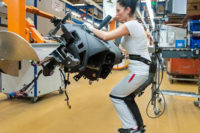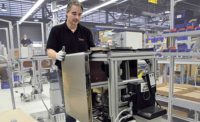Linear Actuator Improves Ergonomics at Printer Manufacturer

Videojet Technologies’s custom carts feature a lifting column that easily accommodates operators from less than 5 feet to more than 6 feet tall. Photo courtesy Thomson Industries Inc.



All food and pharmaceutical manufacturers code their products for freshness, safety and traceability. Many rely on coding, printing and laser-marking machines made by Videojet Technologies Inc.
Since 1969, the company has installed more than 325,000 case coding, continuous ink jet (CIJ), thermal ink jet (TIJ), thermal transfer overprinting and laser-marking units worldwide. It also makes fluids and accessories for the product-identification industry.
Videojet operates 30 manufacturing plants, including its main one at company headquarters in Wood Dale, IL. There, the company builds various CIJs, TIJs and laser-marking machines.
Standard procedure requires a printer to accompany each subassembly as it moves between workstations on the production line. The assembler uses the printer to print out a work order verifying he has completed his task.
Until recently, operating procedures required all items to be moved between workstations on small, tri-level carts. Unfortunately, there often was not enough shelf space to safely store the subassemblies. As a result, they were transported by hand and sometimes misplaced.
Another problem was the cart’s height could not be adjusted. Staff engineers considered replacing the carts with height-adjustable ones purchased off-the-shelf. However, such carts required manual adjustment, which is time-consuming, and they would create difficulties for smaller operators when heavy products are on the cart.
Electrical carts with automatic height adjustment were also investigated. But, they were expensive, and their height adjustment did not fully accommodate all the assemblers.
Finally, Videojet engineers decided to make their own cart—only to face another challenge: finding a lifting column that could accommodate the height differences between assemblers. After some research, they came across the LC200 column made by Thomson Industries Inc.
“The column’s low retracted-length-to-stroke-length-ratio easily accommodates operators from less than 5 feet to greater than 6 feet,” says John Forster, principal manufacturing engineer at Videojet. “Our custom carts also hold the subassemblies and incorporate electrostatic discharge protection.”
The lifting column raises from a collapsed position to full extension along a single linear axis. It features a telescoping leadscrew driven by a geared DC motor that runs quietly and offers high load capacity with minimum current draw.
Engineered polymer bushings provide a high moment load capability at any column height. Dynamic braking ensures short and consistent stops. With the power off, an integrated load-holding brake locks the unit in position.
Made of extruded aluminum, the column also has end-of-stroke-limit switches and requires no maintenance. An optional encoder enables synchronous operation of multiple columns, but was not needed for this single-axis application.
“We use 25 carts because that’s the maximum number we have in process at any one time,” notes Forster. “With the subassemblies traveling with the printers, we have fewer mistakes, our first pass yield has gone up and we are saving a lot of time in the rework process.
“In the near future, we [will] mount our test stands on carts. [This] will be double the number of lasers that we [can] test within the available space.”
For more information on lifting columns and other mechanical motion products, call 540-633-3549 or visit www.thomsonlinear.com.
Looking for a reprint of this article?
From high-res PDFs to custom plaques, order your copy today!








